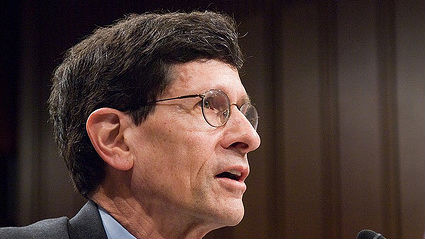The Treasury’s New Brain Trust Reveals Some Surprising Truths

If your house got blown away by a hurricane, you’d probably want to build a stronger house next time, right? The same should be true for financial markets. The government is regulating banks and other financial institutions more strictly now, but what else is it doing to make sure there’s no repeat of the global financial crisis?
Yesterday I attended a seminar by Richard Berner at New York University’s Stern School of Business, where I teach. He’s the former co-head of global economics at Morgan Stanley who now leads the Treasury’s Office of Financial Research. If you haven’t heard of the OFR, don’t worry – it’s only been around since the Dodd-Frank Act. Its job is to find new ways to monitor the markets, identify risks, and improve regulation.
OFR has already uncovered some truths about the markets that run counter to the conventional wisdom. For example, the low interest rates prevalent in today’s markets may not indicate that the underlying assets are relatively safe. Rather, with so much credit available at such low rates, companies and investors may be encouraged to take much greater risks than they would if rates were higher. In other words, risk in the markets may be endogenous to interest rates.
Berner also presented data suggesting that long-term interest rates had been positively correlated with stock prices since the onset of the crisis – as indeed they had been during other crises in the past. This belies the usual refrain that when equity prices rise, bond prices fall. As a result, a portfolio split between stocks and bonds may not be as diversified as you might assume.
OFR is anxious to collect more data, collaborate with economists in academia and the private sector, and disseminate its findings widely. This is what was missing in the past: the federal government didn’t even know what was happening in the biggest financial markets, let alone regulate them, as legislation like the Commodities Futures Modernization Act of 2000 removed whole classes of securities from any kind of scrutiny.
To maximize awareness, OFR will contribute much of its research to the Financial Stability Oversight Council, another creation of Dodd-Frank, which brings together top officials from all the financial regulatory agencies. By sharing information, FSOC hopes to prevent risky practices in one part of the markets from shifting into others as new regulations take hold. These shifts could still happen at the global level, though, and the Treasury is reaching out to its counterparts abroad to bolster monitoring of international transactions. Yet after so many years as an opponent of global financial regulation, Washington may have a tough job persuading them that its newfound zeal is sincere.
Berner has tried to set realistic expectations for OFR and the new regulatory regime. The goal, he said, is not to avert a new financial crisis; crises will happen regardless. But if they can help financial institutions, and the system as a whole, to protect themselves from risks, then the effects of the next crisis won’t be anywhere near as dire as the last one. That, at least, will be progress.





